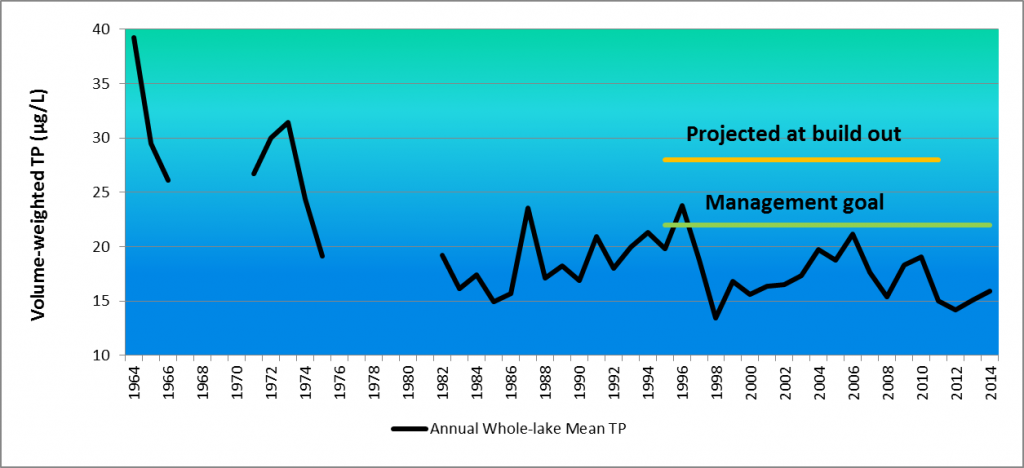LAKE SAMMAMISH WATER QUALITY REPORT SUMMARY
by Rachael Gravon and Deb Bouchard, King County
As the sixth largest lake in Washington and the second largest in King County, Lake Sammamish has been designated a water of statewide significance and is an important and valuable natural resource. It is one of the major recreational lakes in King County, and in 2014 was selected by the United States Fish and Wildlife Service for one of eight national urban wildlife refuge programs. There are both state and county parks along the shore of Lake Sammamish, which is used by fishermen, boaters, water skiers, and picnickers. The lake is lined with homes and supports an array of wildlife.
The Lake Sammamish Water Quality Response to Land Use Change Study evaluated data collected from the 1960s through 2011 to describe how Lake Sammamish has responded to watershed development, in particular to nutrient inputs associated with that development. The study focuses on total phosphorus, chlorophyll-a, and water clarity, parameters often used in lake management to estimate a lake’s productivity, or potential for producing excessive algal growth. The study is part of the ongoing King County Major Lakes Monitoring Program that assesses water quality in Lake Washington, Lake Sammamish, and Lake Union. Both the King County Major Lake and Stream Monitoring Programs are designed to protect the significant investment in freshwater quality improvement and protection made by the people of King County.
Water quality monitoring of Lake Sammamish began in the early 1960s, when the Municipality of Metropolitan Seattle (METRO, which is now merged with King County Department of Natural Resources and Parks) conducted a study of Lake Sammamish water quality to determine whether sewage discharged from the City of Issaquah’s wastewater treatment plant and a large dairy facility were having an adverse effect on the lake. As a result of this study, wastewater diversion was proposed for Lake Sammamish to reduce the total phosphorus inputs into the lake. The diversion decreased the external total phosphorus load to the lake by about 35 percent, and led to a decrease in phosphorus from 32 µg/L to below 20 µg/L (Figure 1). Additionally, chlorophyll-a (a pigment found in algae) declined and water clarity increased, providing evidence that diversion was effective in improving water quality.

Figure 1. Mean annual whole lake volume-weighted total phosphorus in Lake Sammamish, compared with projected at full build-out. Gaps in monitoring data occur between 1967-1970, and 1976-1981. NOTE: 1964-66 data collected by METRO, 1970-75 data collected by University of Washington, 1981-2011 data collected by METRO/King County.
Research in the 1970s and 1980s documented the threat of increasing phosphorus in runoff from impervious surfaces as watershed development increased. Between 1970 and 1990 the percent of developed area in the Lake Sammamish watershed (not including the lake) more than doubled – from 15 percent to 36 percent. This was due primarily to an increase in single family residences in the east side and Issaquah Creek basins (Figure 2). Consistent with the research, annual mean phosphorus levels in the lake were routinely over 20 µg/L by the mid-1990s, likely related to the increased urbanization around the lake. A modeling effort in 1995 predicted that phosphorus levels would continue to increase further — to 28 µg/L at build-out — if measures were not taken.

Figure 2. Single-family residential land use built by decade and current multi-family, commercial, and forest land use (2011).
Concerns about lake water quality influenced the establishment of the inter-jurisdictional Lake Sammamish Initiative, and a citizens’ task force, Partners for a Clean Lake Sammamish. Together, these groups worked to complete the 1996 Lake Sammamish Water Quality Management Plan. The plan called for long-term watershed protections involving forest retention and stormwater controls on new development to retain phosphorus, as well as short-term actions to reduce phosphorus loading to the lake. In addition, two other multi-jurisdictional basin planning efforts were completed in 1994 (East Lake Sammamish and Issaquah Creek) to protect water quality. In 1998, King County implemented its Surface Water Design Manual followed by the 2001 State Stormwater Management Manual for Western Washington.
Interestingly, the assessment of lake conditions in our study showed that mean annual total phosphorus has not changed significantly between 1980 and 2011, even though there has been substantial population growth in the basin and a significant increase in the amount of impervious area. The apparent increase observed in the mid-1990s leveled off over time and did not match models’ projections. Additionally, mean summer chlorophyll-a has remained stable (about 3.5 µg/L), and summer water transparency has averaged over 5.0 meters since 1998.
Wastewater diversion and watershed protections instituted in the mid-1990s have likely contributed to the stable annual lake total phosphorus concentrations. While these results suggest that Lake Sammamish water quality strategies have been effective, enforcement of the strategies and consistent water quality monitoring must continue to ensure that the lake’s water quality does not deteriorate.
The full Lake Sammamish Water Quality Response to Land Use Change report can be found at:
http://your.kingcounty.gov/dnrp/library/2014/kcr2654/kcr2654-rpt.pdf
To view or download Lake Sammamish water quality data, please visit the King County Major Lakes Monitoring Page at:









